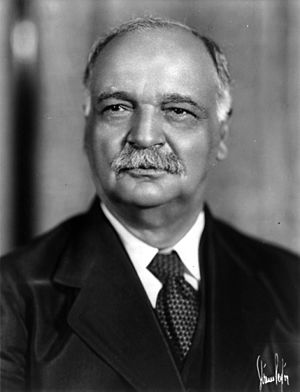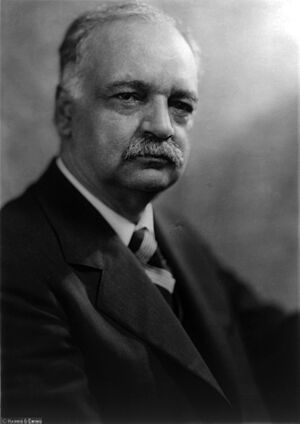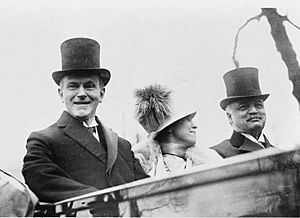Charles Curtis facts for kids
Quick facts for kids
Charles Curtis
|
|
|---|---|

Curtis in 1931
|
|
| 31st Vice President of the United States | |
| In office March 4, 1929 – March 4, 1933 |
|
| President | Herbert Hoover |
| Preceded by | Charles G. Dawes |
| Succeeded by | John Nance Garner |
| Senate Majority Leader | |
| In office November 28, 1924 – March 3, 1929 |
|
| Preceded by | Henry Cabot Lodge |
| Succeeded by | James Eli Watson |
| Leader of the Senate Republican Conference | |
| In office November 28, 1924 – March 3, 1929 |
|
| Preceded by | Office established |
| Succeeded by | James Eli Watson |
| Senate Majority Whip | |
| In office March 4, 1919 – November 28, 1924 |
|
| Leader | Henry Cabot Lodge |
| Preceded by | J. Hamilton Lewis |
| Succeeded by | Wesley Livsey Jones |
| Senate Minority Whip | |
| In office December 13, 1915 – March 3, 1919 |
|
| Leader |
|
| Preceded by | James Wolcott Wadsworth Jr. |
| Succeeded by | Peter G. Gerry |
| President pro tempore of the United States Senate | |
| In office December 4, 1911 – December 12, 1911 |
|
| Preceded by | Augustus Octavius Bacon |
| Succeeded by | Augustus Octavius Bacon |
| United States Senator from Kansas |
|
| In office March 4, 1915 – March 3, 1929 |
|
| Preceded by | Joseph L. Bristow |
| Succeeded by | Henry Justin Allen |
| In office January 29, 1907 – March 3, 1913 |
|
| Preceded by | Alfred W. Benson |
| Succeeded by | William Howard Thompson |
| Member of the U.S. House of Representatives from Kansas |
|
| In office March 4, 1893 – January 28, 1907 |
|
| Preceded by |
|
| Succeeded by | Daniel Read Anthony Jr. (1st district) James Monroe Miller (4th district) |
| Constituency |
|
| Personal details | |
| Born | January 25, 1860 North Topeka, Kansas Territory, U.S. |
| Died | February 8, 1936 (aged 76) Washington, D.C., U.S. |
| Resting place | Topeka Cemetery |
| Nationality |
|
| Political party | Republican |
| Spouse |
Annie Baird
(m. 1884; |
| Children | 3 |
| Signature | |
Charles Curtis (born January 25, 1860 – died February 8, 1936) was an American lawyer and politician. He was a member of the Republican Party from Kansas. Curtis served as the 31st Vice President of the United States from 1929 to 1933. He worked under President Herbert Hoover. Before this, he was the Senate Majority Leader from 1924 to 1929.
Charles Curtis was a member of the Kaw Nation. He was born in the Kansas Territory. This made him the first Native American to reach one of the highest offices in the U.S. government. He was also the first person with non-European family roots to do so. Curtis believed that Native Americans could do well by getting a mainstream education. He also thought they could benefit from joining the wider American culture.
Curtis started his political career at age 32. He won several terms representing his district in Topeka, Kansas. He began serving in the United States House of Representatives in 1892. While in the House, he helped pass the Curtis Act of 1898. This law aimed to end tribal land ownership in Indian Territory. It helped prepare the area to become the State of Oklahoma in 1907. The government wanted Native Americans to become U.S. citizens and own individual land.
Curtis was later elected to the United States Senate. He served one term from 1907 to 1913. Then, he served most of three more terms from 1915 to 1929. His popularity and connections in Kansas and Washington, D.C., made him a strong leader. He became the Republican Whip from 1915 to 1924. Then he was the Senate Majority Leader from 1924 to 1929. In these roles, he helped pass many laws and achieve Republican goals.
Curtis ran for vice president with Herbert Hoover in 1928. They won by a huge amount of votes. In 1932, Curtis became the first U.S. vice president to open the Olympic Games. This happened at the 1932 Summer Olympics in Los Angeles. However, in 1932, Curtis and Hoover lost their re-election bid during the Great Depression. They lost to Franklin D. Roosevelt and John Nance Garner. Charles Curtis is still the highest-ranking Native American to serve in the U.S. federal government.
Contents
Early Life and Heritage
Charles Curtis was born on January 25, 1860. This was in North Topeka, Kansas, in the Kansas Territory. Kansas became a state one year later. Curtis had a mixed background. Three-eighths of his ancestry was Native American. Five-eighths was European American.
His mother, Ellen Papin, was from the Kaw, Osage, Potawatomi, and French groups. His father, Orren Curtis, had English, Scottish, and Welsh roots. On his mother's side, Curtis was a descendant of important chiefs. These included Chief White Plume of the Kaw Nation and Chief Pawhuska of the Osage.
When he was a baby, Curtis spoke French and Kansa. He learned these from his mother. She died in 1863 when he was three. He lived with his maternal grandparents on the Kaw reservation. He often returned to them later. He loved racing horses and became a very good jockey.
In 1868, when Charles was eight, 100 Cheyenne warriors came to the Kaw Reservation. The Kaw men rode out to meet them. White settlers were scared and hid. After about four hours, the Cheyenne left. No one was hurt. During this time, an eight-year-old Charles Curtis, nicknamed "Indian Charley," rode to Topeka to get help from the governor.
Curtis later officially rejoined the Kaw Nation. The Kaw people had moved from Kansas to Indian Territory when he was a teenager. Both sets of his grandparents had a big impact on him. After living on the reservation, he returned to Topeka. He lived with his paternal grandparents while attending Topeka High School. Both grandmothers encouraged him to get an education.
Curtis studied law by working at a law firm. He passed his law exams in 1881. He then started his own law practice in Topeka. He also worked as a prosecutor for Shawnee County, Kansas, from 1885 to 1889.
Family Life
On November 27, 1884, Charles Curtis married Annie Elizabeth Baird. They had three children: Permelia, Henry, and Leona. Curtis and his wife also gave a home to his younger sister, Dolly Curtis, before she married. Annie died in 1924.
When Curtis became vice president in 1929, he was a widower. His sister, Dolly Curtis Gann, became his official hostess for social events. She lived in Washington, D.C., with her husband. Dolly Gann insisted on being treated as the second most important woman in government at social events. The diplomatic group agreed to change their rules for her.
Curtis is the last vice president who was unmarried during his entire time in office.
A Career in Politics
Serving in the House of Representatives
Curtis was first elected to the United States House of Representatives in 1892. He was a Republican. He was re-elected for six more terms. He was a friendly person and made an effort to get to know his voters. He treated them like personal friends.
In 1902, the Kaw Allotment Act was passed. This law ended the Kaw Nation as a legal group. It divided their shared land among its members. Curtis and his three children, as tribal members, received about 1,625 acres of Kaw land in Oklahoma.
Curtis served in the House from March 4, 1893, to January 28, 1907.
Becoming a Senator


Curtis left the House after being elected to the United States Senate by the Kansas Legislature. This was to fill a vacant seat. He served the rest of that term, which ended on March 4, 1907. At that time, senators were chosen by state legislatures, not by direct vote. The legislature also elected him for the next full Senate term. He served from March 4, 1907, to March 3, 1913. In 1912, Democrats took control of the Kansas legislature, so Curtis was not re-elected.
In 1913, the 17th Amendment was passed. This allowed people to directly vote for their senators. In 1914, Curtis was elected to Kansas's other Senate seat by popular vote. He was re-elected in 1920 and 1926. In total, he served in the Senate from March 4, 1915, to March 3, 1929. He then resigned to become vice president.
During his time in the Senate, Curtis held many important roles. He was the President pro tempore. He also led committees on government spending and Native American issues. He was elected as the Senate Minority Whip for ten years. Then he became the Senate Majority Leader for four years. He was respected for his ability to work with members from both political parties.
In 1923, Curtis and another Kansas representative, Daniel Read Anthony, Jr., proposed the first version of the Equal Rights Amendment. This amendment aimed to give equal rights to all Americans. However, it did not pass at that time.
Curtis was known for not giving many speeches. He was also famous for keeping a detailed record of everyone he met. He used a black notebook and later a card index to remember people. This helped him connect with voters and other politicians.
Vice Presidency (1929–1933)
Curtis received many votes for president at the 1928 Republican National Convention. However, Herbert Hoover won the nomination. Curtis had been a leader against Hoover. But when he was offered the vice-presidential nomination, he accepted it.
Hoover did not give many speeches during the 1928 election. But Curtis traveled all over the country and spoke almost every day. The Hoover–Curtis team won the 1928 presidential election by a large margin. They received 444 out of 531 Electoral College votes.
Curtis resigned from the Senate the day before he became vice president. He took his oath of office in the Senate Chamber. Then, the presidential group went to the U.S. Capitol for Hoover's inauguration. Curtis arranged for a Native American jazz band to play at the inauguration.
Curtis's election as vice president was historic. He was the only person from Kansas to hold the job. He was also the only Native American and the first person of color to be vice president. Curtis decorated his office with Native American items. He also posed for pictures wearing Indian headdresses. He was 69 years old when he took office, making him the oldest incoming vice president at that time.
Curtis was the first vice president to take his oath of office on a Bible, just like the president does. He also hired Lola M. Williams as his private secretary. She was one of the first women allowed on the Senate floor, which was usually only for men.
After the Great Depression started in 1929, Curtis suggested a five-day work week. He thought this would help with unemployment. He also made a remark in 1930 that "good times are just around the corner." This statement was later wrongly linked to Hoover and became a problem for their political campaign.
At the 1932 Republican National Convention, Hoover was chosen again for president. Curtis also won the nomination for vice president for a second time.
Curtis opened the 1932 Summer Olympics in Los Angeles. This made him the first U.S. executive branch officer to open the Olympic Games. He also cast three tie-breaking votes in the Senate.
The problems of the Great Depression grew during Hoover's time in office. This led to their defeat in the 1932 election. Franklin D. Roosevelt won the presidency. Curtis's term as vice president ended on March 4, 1933. His last duty was to give the oath of office to his successor, John Nance Garner.
After the Vice Presidency
After his time as vice president, Curtis stayed in Washington, D.C.. He went back to working as a lawyer. He had many connections from his long career in government. He died in Washington, D.C., from a heart attack on February 8, 1936. He was 76 years old. As he wished, he was buried next to his wife at the Topeka Cemetery in Kansas.
Legacy and Honors
- He was the only United States vice president to open the 1932 Summer Olympics.
- He was featured on the cover of Time magazine three times. These were on December 20, 1926, June 18, 1928, and December 5, 1932.
- His house in Topeka, Kansas is now a state historic site. The Charles Curtis House Museum is open to visitors.
- He was the only multiracial person to serve as Vice President of the United States until Kamala Harris in 2021.
Images for kids
-
Vice President Curtis receives a peace pipe from Red Tomahawk, slayer of Sitting Bull
See also
 In Spanish: Charles Curtis para niños
In Spanish: Charles Curtis para niños
- Curtis Act of 1898
- List of Chairpersons of the College Republicans
- List of people on the cover of Time Magazine: 1920s – December 20, 1926, and June 18, 1928
- List of people on the cover of Time Magazine: 1930s – December 5, 1932
- List of Native Americans in the United States Congress






